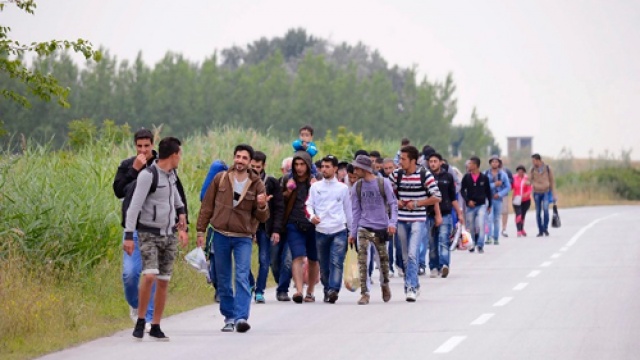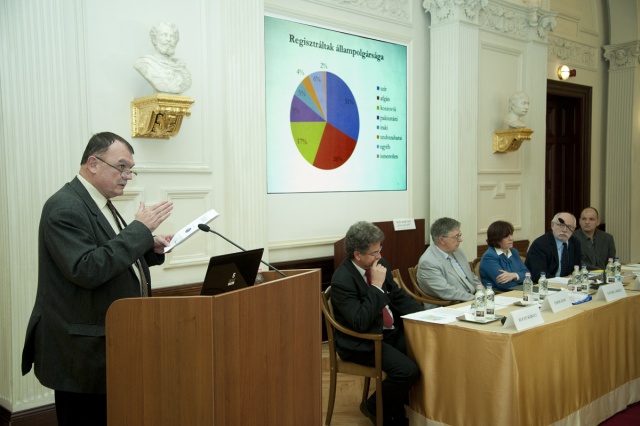Factors, directions and prospects of the escalating migration towards Europe in 2015
The flow of refugees into Europe is not likely to stop, or even decrease, in this century according to the important findings of the Academy research group set up at the request of the Ministry of Interior at the Hungarian Academy of Sciences in the beginning of September to organise and carry out previously started research about migration processes.
In its study and proposals published on 29 October, the body suggests, among other things, that the Government should pay more attention to policy handling of the migration process, seemingly unstoppable so far.
In what ways could Hungary benefit from such a phenomenon that causes serious issues and malfunctioning infrastructure in some parts of the country, puts the tolerance of thousands of people to the test, and also poses some risk in international politics? The objective of finding answers to these questions was bequeathed to nearly thirty geographers, minority studies researchers, lawyers, economists and regional issues experts of five institutes of three MTA research centres.
Their work is managed with a weekly meeting committee led by Ádám Török, General-Secretary of MTA. The committee members are Károly Fazekas, General Director of MTA Research Centre for Economic and Regional Studies, András Körösényi, General Director of MTA Centre for Social Sciences, Attila Papp Z., Director of the Institute for Minority Studies of MTA Centre for Social Sciences, and Károly Kocsis, Director of the Geographical Institute of Research of MTA Research Centre for Astronomy and Earth Sciences.
Migration research has been conducted at the Academy before, with the investigation of the settlement of migrants in Hungary as its primary focus. However, due to the fact that the number of illegal border crossings rose from the tens or hundreds to several thousand a day in 2015, and at least 97% of registered asylum seekers move on to another country, scientists, instead of analysing integration problems, elaborated new methods of research and analysis to study the origin and structure of the new migration flow and to reveal its impacts on the labour market.

"The Hungarian Academy of Sciences has accomplished one of its chief public duties by recently expanding and fundamentally amending its previous migration research at the request of the Ministry of Interior," László Lovász, President of MTA, said at the press conference, revealing the findings of the scientific committee thus far. He added, "As an advisor to the nation, the duties of the Hungarian Academy of Sciences include not only conducting research of strategic importance on the future of Hungary, but also making proposals for decision makers on the basis of its findings, thus contributing to effective policy preparation." According to the president, all this is crucial partly because we need to face the fact that global environmental and political changes will mean long-term, probably decades-long, tasks for scientists.
Zsuzsanna Végh, General Director of the Office of Immigration and Nationality regarded migration as the most important political event of present time and as a challenge which is extremely difficult to provide a correct solution to. "While migration is a topic of continuous political debates, much less is said about what is going to happen to those who stay. However, it would be essential to deal with the process of social adjustment and integration," Végh stated. The general director thanked the Academy researchers for their work, and expressed her hope that the findings of the survey would spark debates and discussions.
The research study conducted by the working group starts off analysing the immigration registration data recorded and collected in the first eight months of 2015, then goes on to survey the social and economic status of refugee-sending (or more appropriately, refugee-producing) countries with regard to the role they may play in the migration towards Europe. Due to the limited extent of their detailedness, the available official data do not allow for an in-depth development of correlations; however, they provide useful information about the dynamics of the migration process and the demographic composition of newcomers.
Integration and safety problems may occur in the long run
One of the most important conclusions drawn by the working group about the group of more than 132,000 people studied is that the structure of immigration has changed. The proportion of migrants of Syrian origin has risen, and in connection with this, the relative weight of Afghans, the other large group, has decreased. Young men are the overwhelming majority, most of whom may have run away not only from the war, but also from harsh living conditions to “try their luck” in Europe, the researchers remark. “This alone does not call into question this group’s successful integration into Western Europe; however, the phenomenon might cause serious integration and safety problems in the long run,” they add. On the other hand, the researchers suggest that these young men are assumed to have work experience at places of higher standards, to be skilled, and to actually intend to work. In this case, the influx of work force could truly lessen work force problems in Western European “core countries” without imposing considerable safety, political and fiscal risks.

A growing number of refugee-producing countries
Based on the international analysis of the working group, the influx of migrants is expected to fail to stop or even slow down in the second half of the 2010s, which will hold true even if the situation stabilises in Syria, Iraq or Afghanistan. In addition, climate change is likely to further boost the process of migration.
An analysis of migration routes shows that it is probable that the volume of migration will not decrease either. The group of refugee-producing countries is expanding to the west. Migration from Ethiopia, Eritrea and Somalia began growing earlier, and lately the western part of Sub-Saharan Africa has appeared among the refugee-producing regions. Migration from Bangladesh is also on the rise.
Proposals with regard to migrants staying in Hungary
The researchers of MTA stressed that their intention was to support policy decisions and have several proposals drawn up for the government. According to their suggestions, there is a need for settlement incentives and a system of institutions and assistance capable of receiving even a larger group of refugees wishing to stay in Hungary in Hungary, complemented with language education, professional training and reasonable living allowances for those who can be expected to adjust successfully.
It is clear that the sources alleviating the supply problems of the Hungarian labour market in the past years (such as the influx of Hungarian-speaking labour from neighbouring countries) are about to run out. Consequently, it is reasonable to consider every possible source of foreign labour, bearing in mind that recent experience shows the number of migrants wishing to settle down in Hungary is rather low. During the period of 2010-2015, there were many examples showing that beneficiaries of Hungarian integration support moved to the west within a few years.
According to the MTA proposal, the Hungarian government ought to pay more attention to the seemingly unstoppable immigration process in terms of policy and the labour market. Similarly, it is essential to formulate policies considering aspects of macroeconomics, geostrategy, water management, sanitation, culture, religion, etc.
The researchers find it important to examine the legal and political background conditions of migration. They warn that these conditions may not only appear as determinants for, but also as barriers to the margins of decision-making. In a developed European society and constitutional state, institutional causes may make the balanced treatment of migration issues a more toilsome, more demanding task when compared to the way certain Middle Eastern states admit millions of citizens from neighbouring countries: in large amounts, but often under humiliating circumstances, and with an almost complete lack of guarantees. An examination of the background conditions may highlight that a certain way of treating migration issues can influence the development of the legal and political system of the given admitting country.
Why does the study not deal with the risk of terrorism?
The authors state: "We do not possess empirical, first-hand sources, while our secondary sources (most importantly, daily newspapers and specialised journals from Western Europe) seem to simplify the issue. They usually reason that it is simpler for terrorist organizations to get those members to Europe that already hold a passport than to expose their people to the efforts and risks of months-long migration. Such simplifying statements should not be argued on purely logical grounds; still, for lack of data, they cannot be refuted either.
The slow transformation of Western European public opinion
The study says Western Europeans’ attitudes towards the booming migration were more based on ethics and humanity than on practical politics. A slow but continuous transformation of Western European (especially German and Austrian) public opinion can be observed, parallel to the populations of those destination countries encountering refugees more and more on a personal level. The powers of high politics have realised that by treating migration exclusively as an issue of ethics and solidarity and forcing short-term economic and social aspects into the background, they risk their support (and give an advantage to radical/populist powers). Ethical considerations are not to be overshadowed, but the analysis of the working group focussed on economic, social and geographical aspects.
Possible future research
The research group wishes to carry on with its work, involving further research areas. Time constraints did not allow an examination of several factors of the migration process which are important but mostly well-known among the cultivators of social sciences only who apply the tools of quantitative analysis on an infrequent basis. Let us make mention of the potential of a historical, cultural, social, anthropological and, last but not least, religious analysis. These examinations could perhaps help us better understand the behaviour and motivations of groups of people that arrive in the country but often move on. Researchers also find it important that the above aspects play a bigger role than before in professional debates in Hungary.



